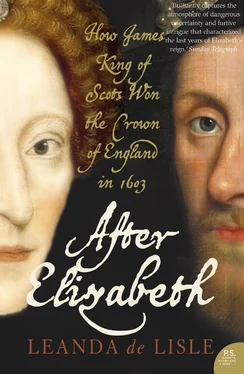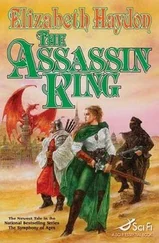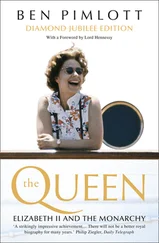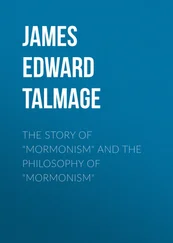Harington had been granted an audience with the Queen soon after his arrival at Whitehall. As usual he was escorted from the Presence Chamber, where courtiers waited bareheaded to present their petitions, along a dark passage and into the Privy Chamber where his godmother awaited him. 15 A mural by Hans Holbein the Younger dominated the room. The massive figure of Henry VIII stood, hand on hips, gazing unflinchingly at the viewer. His third wife Jane Seymour, the mother of his son Edward VI, was depicted on his left and above him his mother, Elizabeth of York, with his father, Henry VII. The mural boasted the continuity of the Tudor dynasty, a silent reproach to the childless spinster Harington now saw before him. Contemporaries remarked often on Elizabeth’s similarity to her grandfather. When she was young they saw it in her narrow face and the beautiful long hands of which she was so proud. As she grew older she developed her grandfather’s wattle, a ‘great goggle throat’ that hung from her chin. 16 But she did not now look merely old. She appeared seriously ill.
Harington was shocked by what he saw and frightened for the future. Elizabeth had been increasingly melancholic since the Essex revolt, but he was now convinced that she was dying. He confided his thoughts in a letter to the one person he trusted: his wife, Mary Rogers, who was at home in Somerset caring for their nine children.
Sweet Mall,
I herewith send thee what I would God none did know, some ill bodings of the realm and its welfare. Our dear Queen, my royal godmother, and this state’s natural mother, doth now bear signs of human infirmity, too fast for that evil which we will get by her death, and too slow for that good which she shall get by her releasement from pains and misery. Dear Mall, How shall I speak what I have seen, or what I have felt? – Thy good silence in these matters emboldens my pen … Now I will trust thee with great assurance, and whilst thou dost brood over thy young ones in the chamber, thou shalt read the doings of thy grieving mate in the court … 17
Elizabeth received Harington seated on a raised platform. Her ‘little black husband’ John Whitgift, the Archbishop of Canterbury whose plain clerical garb contrasted so starkly with her bejewelled gowns and spangled wigs, was beside her. * It was believed that Elizabeth used her glittering costumes to dazzle people so they ‘would not so easily discern the marks of age’, but if so, she no longer considered them enough. Increasingly afraid that any intimation of mortality would attract dangerous speculation on her successor she had taken to filling out her sunken cheeks with fine cloths and was also ‘continually painted, not only all over the face, but her very neck and breast also, and that the same was in some places near half an inch thick’. 18 There were some things, however, that make-up could not hide. When Elizabeth spoke it was apparent that her teeth were blackened and several were missing. Foreign ambassadors complained it made her difficult to understand if she spoke quickly. But during Harington’s audience this was not a problem; her throat was so sore and her state of mind so troubled that she could barely speak at all.
The rebellion in Ireland that had cost Elizabeth so much in men, money and peace of mind was near its end. The arch rebel Tyrone was offering his submission, but it brought Elizabeth no joy; memories of Essex’s betrayals were crowding in. She whispered to Whitgift to ask Harington if he had seen Tyrone? Harington had witnessed Essex making the truce with Tyrone in 1599 and later met him in person. He still trembled at the memory of Elizabeth’s fury with him about it when he had returned to England, and he now answered her carefully, saying only, ‘I had seen him with the Lord Deputy.’ At this, Elizabeth looked up with an expression of anger and grief and replied ‘Oh, now it mindeth me that you was one who saw this man elsewhere,’ and she began to weep and strike her breast. ‘She held in her hand a golden cup, which she often put to her lips; but in sooth her heart seemed too full to lack more filling,’ Harington told his wife.
As the audience drew to a close Elizabeth rallied and she asked her godson to come back to her chamber at seven o’clock and bring some of the light-hearted verses and witty prose for which he was famous. Harington dutifully returned that evening and read Elizabeth some verses. She smiled once but told him, ‘When thou dost find creeping time at thy gate, these fooleries will please thee less; I am past my relish for such matters. Thou seeest my bodily meat doth not suit me well; I have eaten but one ill-tasted cake since yesternight.’ 19 The following day Harington saw Elizabeth again. A number of men had arrived at her request only to be dismissed in anger for appearing without an appointment: ‘But who shall say that “Your Majesty hath forgotten”?’ Harington asked Mall.
No one dared to voice openly the seriousness of Elizabeth’s condition, but Harington did find ‘some less mindful of what they are soon to lose, than of what they may perchance hereafter get’. 20 He told his wife he had attended a dinner with the Archbishop and that many of Elizabeth’s own clerics appeared to be ‘well anointed with the oil of gladness’. But the spectacle of Elizabeth’s misery amidst the feasting pricked Harington’s conscience. In his Tract on the Succession he had wasted no opportunities to dwell on the unpopularity of her government and to contrast her failings as an aged Queen with James VI’s youth, vigour and masculinity. Now he could not suppress memories of all the kindness she had shown him, ‘her watchings over my youth, her liking to my free speech and admiration of my little learning … have rooted such love, such dutiful remembrance of her princely virtues, that to turn askant from her condition with tearless eyes, would stain and foul the spring and fount of gratitude’. 21
Harington’s eyes, however, tear-filled or not, remained as fixed on the future as those of everyone else, and he was comforted by the realisation that his examination of the succession issue had been completed with exquisite timing.
The question of the succession had dominated the history of the Tudor dynasty and would shape events to come. The first Tudor king, Henry VII, had been a rival claimant to a reigning monarch until his army killed Richard III at the battle of Bosworth Field in 1485. The victory came at the end of a long period of civil strife in which Harington’s great-grandfather, James Harington, was allied with the losing side – an error that cost the family much of their land in the north of England. Henry was fearful that such families would rise up against him if a rival candidate to his crown emerged and so he worked hard to achieve a secure succession. He had two sons to ensure the future of his line and he bolstered his claim by creating a mythology that anchored the Tudors in a legendary past.
Henry VII claimed that his ancestor, Owen Tudor, was a direct descendant of Cadwallader, supposedly the last of the British kings. This made the Tudors the heirs of King Arthur and through them, it was said, Arthur would return. 22 Henry even named his eldest son Arthur, but the boy died aged fifteen not long after his marriage to Catherine of Aragon. It was thus his second son, Henry VIII, who inherited the crown, as well as his brother’s bride. Henry and Catherine had a daughter, the future Mary I, but no sons. Henry saw this lack of a male heir as an apocalyptic failure fearing that the inheritance of the throne by a mere queen regnant could plunge England back into civil war. He became convinced that God had punished him for having married his brother’s wife and sought an annulment from the Pope. When the Pope, under pressure from Catherine’s Hapsburg nephew, Charles V, denied it to him, he made himself the head of the Church in England. Justifications for Henry’s new title were found in the various ‘histories’ of Arthur, but his actions had coincided with the revolution in religious opinion in Europe begun by the German monk, Martin Luther. One of Henry’s chief researchers was a keen follower of Luther’s teachings and although Henry had once written against Luther he chose to reward Thomas Cranmer’s service in ‘discovering’ the royal supremacy by making him Archbishop of Canterbury. Centuries of Catholic culture and belief were to be overturned in favour of new Protestant ideas as Henry divorced Catherine, declared Mary illegitimate and married ‘one common stewed whore, Anne Boleyn’, as the Abbot of Whitby called her.
Читать дальше












